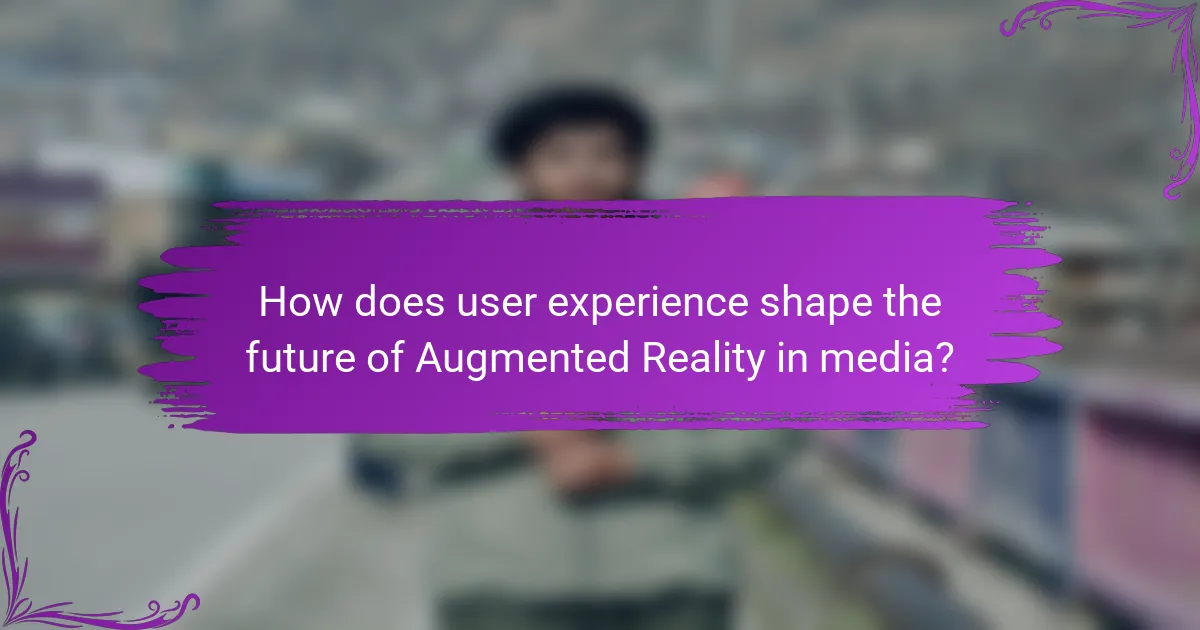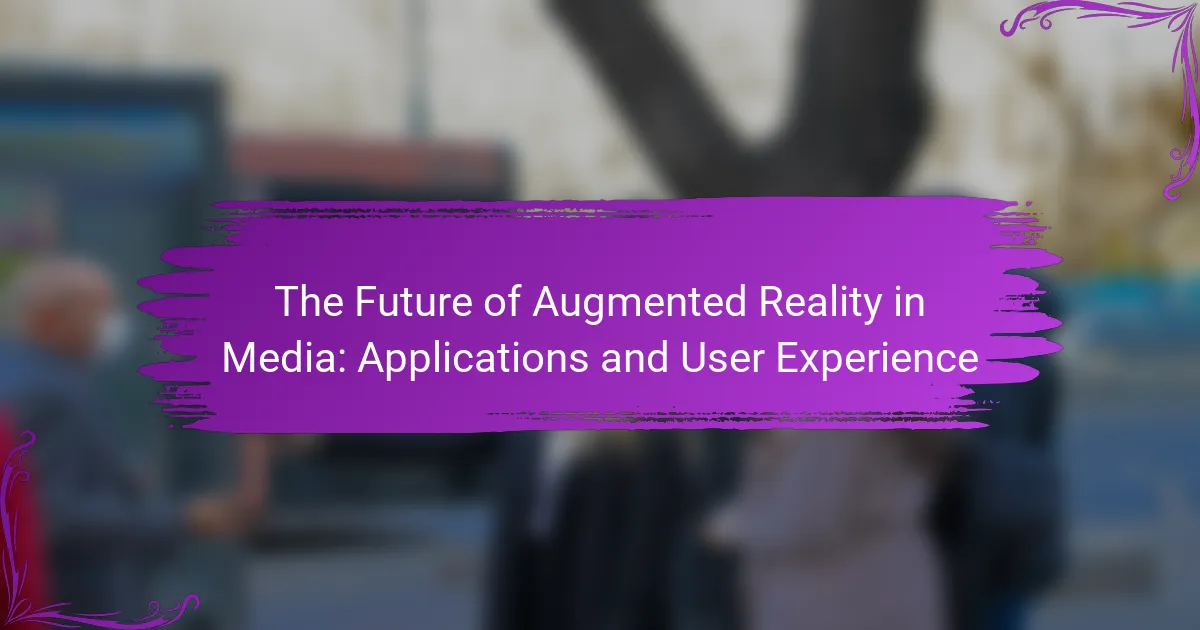
What is Augmented Reality in Media?
Augmented Reality (AR) in media is the integration of digital information with the user’s environment in real-time. This technology enhances the perception of reality by overlaying digital content onto the physical world. AR can be experienced through devices such as smartphones, tablets, and AR glasses. It allows users to interact with both virtual and real-world elements simultaneously. For example, AR applications can provide interactive storytelling, immersive advertising, and enhanced gaming experiences. The use of AR in media has been shown to increase user engagement and retention. According to a report by Statista, the AR market is projected to reach $198 billion by 2025, indicating its growing significance in the media landscape.
How does Augmented Reality enhance media experiences?
Augmented Reality (AR) enhances media experiences by overlaying digital content onto the real world. This integration creates immersive interactions that engage users more deeply. AR allows for interactive storytelling, enabling viewers to participate in narratives rather than just observe. For instance, AR in gaming transforms physical spaces into interactive environments. Studies show that AR can increase user engagement by up to 50%. Additionally, AR facilitates personalized content delivery, tailoring experiences to individual preferences. This personalization fosters a stronger emotional connection with the media. Overall, AR redefines how users consume and interact with media, making experiences more dynamic and engaging.
What technologies are involved in Augmented Reality for media?
Augmented Reality (AR) for media involves several key technologies. These include computer vision, which enables devices to interpret and understand visual information from the real world. Depth tracking is another crucial technology, allowing AR systems to gauge the distance of objects in the environment. Sensor fusion integrates data from multiple sensors to enhance the accuracy of AR experiences.
Additionally, display technologies such as smartphones, tablets, and AR glasses are essential for rendering AR content. Graphics rendering engines, like Unity and Unreal Engine, facilitate the creation of immersive AR environments. Furthermore, cloud computing supports the storage and processing of large amounts of data necessary for real-time AR applications.
Together, these technologies create engaging and interactive media experiences that blend digital content with the physical world.
How do users interact with Augmented Reality in media?
Users interact with Augmented Reality (AR) in media through various engaging methods. They utilize mobile devices to access AR applications, enhancing their viewing experience. Users can scan real-world objects to trigger digital content, creating an immersive environment. Interaction occurs through touch gestures, allowing users to manipulate virtual elements. Voice commands also enable hands-free navigation within AR experiences. Furthermore, social sharing features allow users to showcase their AR interactions on social media platforms. Research indicates that 70% of users feel more connected to brands using AR, validating its effectiveness in media engagement.
What are the key applications of Augmented Reality in media?
Augmented Reality (AR) in media enhances user engagement and interactivity. Key applications include immersive advertising, where brands create interactive experiences. AR also facilitates live event enhancements, providing real-time information to viewers. In journalism, AR offers interactive storytelling, allowing audiences to explore news stories in depth. Additionally, AR is used in gaming, blending digital content with the real world for enhanced gameplay. Educational content benefits from AR, providing interactive learning experiences. These applications demonstrate how AR transforms media consumption, making it more engaging and informative.
Which media sectors are most impacted by Augmented Reality?
Augmented Reality (AR) significantly impacts several media sectors. The gaming industry utilizes AR to enhance user engagement and interactivity. For instance, Pokémon GO revolutionized mobile gaming by integrating real-world elements. The retail sector incorporates AR for virtual try-ons, improving customer experiences. Brands like IKEA allow users to visualize furniture in their homes using AR. Education also benefits from AR, providing immersive learning experiences. Institutions use AR to create interactive lessons that enhance student understanding. The advertising sector leverages AR for innovative campaigns, capturing consumer attention effectively. Brands utilize AR to create memorable and interactive advertisements. Overall, AR reshapes how these media sectors engage with their audiences.
How is Augmented Reality used in advertising and marketing?
Augmented Reality (AR) is used in advertising and marketing to enhance consumer engagement. AR allows brands to create interactive experiences that captivate users. For example, furniture retailers use AR to let customers visualize products in their homes. This technology increases consumer confidence in purchasing decisions. According to a study by Deloitte, 88% of consumers prefer brands that offer AR experiences. Additionally, AR campaigns can boost brand recall and recognition. Companies like IKEA and L’Oréal have successfully integrated AR into their marketing strategies. These efforts demonstrate the effectiveness of AR in driving consumer interest and sales.

What are the future trends of Augmented Reality in media?
Future trends of Augmented Reality in media include enhanced personalization, improved user engagement, and integration with artificial intelligence. Personalization will allow content to be tailored to individual preferences, creating a more immersive experience. Improved user engagement will result from interactive storytelling techniques that captivate audiences. Integration with AI will enable real-time data analysis, enhancing content relevance. Additionally, advancements in hardware, like AR glasses, will make AR experiences more accessible. According to a report by Statista, the AR market is expected to reach $198 billion by 2025, indicating significant growth and investment in this technology.
How is technology evolving to support Augmented Reality in media?
Technology is evolving to support Augmented Reality (AR) in media through advancements in hardware and software. Enhanced processing power in devices allows for more complex AR applications. Improved graphics rendering capabilities create more realistic AR experiences. High-resolution displays enhance visual clarity and detail in AR content. Additionally, the development of 5G networks provides faster data transmission, enabling real-time AR interactions. Machine learning algorithms are being integrated to improve object recognition and tracking in AR environments. Companies like Apple and Google are investing in AR frameworks to facilitate easier development. For example, Apple’s ARKit and Google’s ARCore offer tools for creators to build AR experiences seamlessly. These advancements collectively enhance user engagement and interaction in media.
What role do mobile devices play in the future of Augmented Reality?
Mobile devices will be central to the future of Augmented Reality (AR). They provide the hardware necessary for AR applications, including cameras, sensors, and processing power. The widespread adoption of smartphones means that more users can access AR experiences. According to a report by Statista, the number of AR users is expected to reach 1.73 billion by 2024, largely driven by mobile devices. Mobile devices enable AR applications in various sectors, including gaming, education, and retail. For instance, apps like Pokémon GO have demonstrated how mobile AR can enhance user engagement. The portability of mobile devices allows users to experience AR in their everyday environments. This accessibility will drive innovation and development in AR technologies. Overall, mobile devices will facilitate the integration of AR into daily life, shaping its future.
How will advancements in AR hardware influence media experiences?
Advancements in AR hardware will significantly enhance media experiences. Improved hardware will provide higher resolution displays. This leads to sharper and more vibrant visuals. Enhanced processing power will enable more complex graphics. Users will experience real-time interactions with digital content. Better sensors will allow for more accurate tracking of movements. This results in a more immersive experience. According to a report by Deloitte, AR can increase user engagement by up to 70%. These advancements will transform storytelling in media, making it more interactive and engaging.
What are the potential challenges facing Augmented Reality in media?
Augmented Reality (AR) in media faces several potential challenges. One major challenge is the high cost of development and implementation. Creating quality AR content often requires significant investment in technology and expertise. Another challenge is user accessibility. Not all consumers have access to AR-enabled devices, limiting the audience reach. Additionally, there are technical limitations such as lag and performance issues that can hinder user experience. Privacy concerns also pose a challenge, as AR applications often require access to personal data. Furthermore, content creation for AR can be complex and requires specialized skills. Lastly, there is a risk of user disorientation or discomfort when interacting with AR environments. These challenges need to be addressed for AR to thrive in the media landscape.
How do privacy concerns affect Augmented Reality applications?
Privacy concerns significantly impact Augmented Reality (AR) applications. These concerns arise from the potential for unauthorized data collection. AR applications often require access to personal information and real-time environment data. For instance, apps may utilize cameras and location services, raising fears about surveillance. Users worry about how their data is stored and used. A 2021 survey found that 70% of users are hesitant to share personal data with AR apps. This hesitance can lead to reduced user engagement and trust. Companies must address these concerns to enhance user experience and adoption rates.
What technical limitations currently hinder Augmented Reality in media?
Technical limitations that currently hinder Augmented Reality (AR) in media include hardware constraints, software compatibility issues, and limited user interactivity. Hardware limitations involve the processing power and battery life of devices. Many AR applications require significant computational resources, which can lead to performance issues. Software compatibility can restrict the functionality of AR applications across different platforms. This inconsistency can frustrate users and limit the reach of AR content. Limited user interactivity arises from the current state of AR technology, which often does not allow for seamless engagement or real-time responsiveness. These factors collectively impede the widespread adoption and effectiveness of AR in media.

How does user experience shape the future of Augmented Reality in media?
User experience significantly influences the future of Augmented Reality (AR) in media. Enhanced user experience leads to increased engagement and satisfaction. AR applications are designed to be intuitive and user-friendly. A seamless experience encourages users to adopt AR technologies more readily. According to a study by Statista, 70% of users report higher satisfaction with AR applications that prioritize user experience. Improved user interfaces and interactive features enhance content consumption. As user feedback shapes AR development, companies can tailor experiences to meet audience needs. This iterative design process fosters innovation in AR media applications. Ultimately, a focus on user experience drives the growth and evolution of AR in the media landscape.
What factors contribute to a positive user experience in Augmented Reality?
User experience in Augmented Reality (AR) is influenced by several key factors. Intuitive user interface design enhances interaction ease. High-quality graphics and realistic visuals improve immersion. Responsive tracking and low latency contribute to seamless experiences. Contextual relevance of AR content increases user engagement. Accessibility features ensure inclusivity for diverse users. User feedback mechanisms allow for continuous improvement. Research indicates that these factors significantly impact overall satisfaction and usability in AR applications.
How does user feedback influence the development of Augmented Reality applications?
User feedback significantly influences the development of Augmented Reality (AR) applications. Developers use feedback to identify user needs and preferences. This information guides feature enhancements and user interface improvements. User testing sessions often reveal usability issues that developers may not have anticipated. Feedback also helps in assessing the effectiveness of AR experiences. For instance, a study by H. H. H. A. Alshahrani and A. M. Alharthi (2021) found that user engagement increased when developers incorporated feedback into design iterations. Continuous feedback loops ensure that AR applications remain relevant and user-friendly. Thus, user feedback is crucial for creating successful and engaging AR applications.
What design principles are essential for effective Augmented Reality interfaces?
Effective Augmented Reality (AR) interfaces rely on several essential design principles. These principles include clarity, context, feedback, and user control. Clarity ensures that AR elements are easily distinguishable from the real world. Context involves placing digital information relevant to the user’s environment. Feedback provides users with immediate responses to their actions, enhancing interaction. User control allows individuals to manipulate AR elements intuitively. Research indicates that adhering to these principles improves user experience and engagement in AR applications. A study published in the Journal of Augmented and Virtual Reality highlights that effective design significantly impacts user satisfaction and usability in AR environments.
What are best practices for implementing Augmented Reality in media?
Best practices for implementing Augmented Reality in media include ensuring user engagement and clear purpose. The AR experience should enhance the content rather than distract from it. User interface design must be intuitive to facilitate ease of use. Testing with real users is crucial for identifying usability issues. Feedback loops can help refine the AR experience over time. Ensuring compatibility across devices maximizes accessibility for users. Analytics should be utilized to measure user interaction and effectiveness. Finally, keeping content updated maintains user interest and relevance.
How can media companies effectively integrate Augmented Reality into their content?
Media companies can effectively integrate Augmented Reality (AR) into their content by creating interactive experiences that enhance user engagement. They can utilize AR to overlay digital information onto real-world environments. This approach allows users to interact with content in a more immersive way. For example, AR can be used in news reporting to provide real-time data visualization. Studies show that interactive content increases viewer retention by up to 80%. Additionally, AR can be applied in advertising to create compelling brand experiences. Brands leveraging AR have reported higher click-through rates and improved customer satisfaction. By focusing on user-friendly applications, media companies can ensure broader accessibility and appeal.
What strategies can enhance user engagement with Augmented Reality experiences?
Interactive content enhances user engagement with Augmented Reality experiences. Users are more likely to participate when they can interact with the AR environment. Incorporating gamification elements, such as rewards or challenges, increases motivation. Personalization of experiences based on user preferences fosters deeper connections. Clear instructions and intuitive interfaces improve usability and satisfaction. Social sharing features encourage users to showcase their experiences. Continuous updates and new content keep the experience fresh and engaging. Research indicates that immersive storytelling increases retention and emotional connection with users.
The main entity of this article is Augmented Reality (AR) in media, which refers to the integration of digital information with the user’s physical environment in real-time. The article explores how AR enhances media experiences through interactive storytelling, immersive advertising, and personalized content delivery, significantly increasing user engagement and retention. It discusses the key technologies involved in AR, the various applications across sectors like gaming, education, and advertising, and the future trends shaping its development. Additionally, the article addresses user experience factors, design principles for effective AR interfaces, and best practices for media companies to successfully integrate AR into their content.



